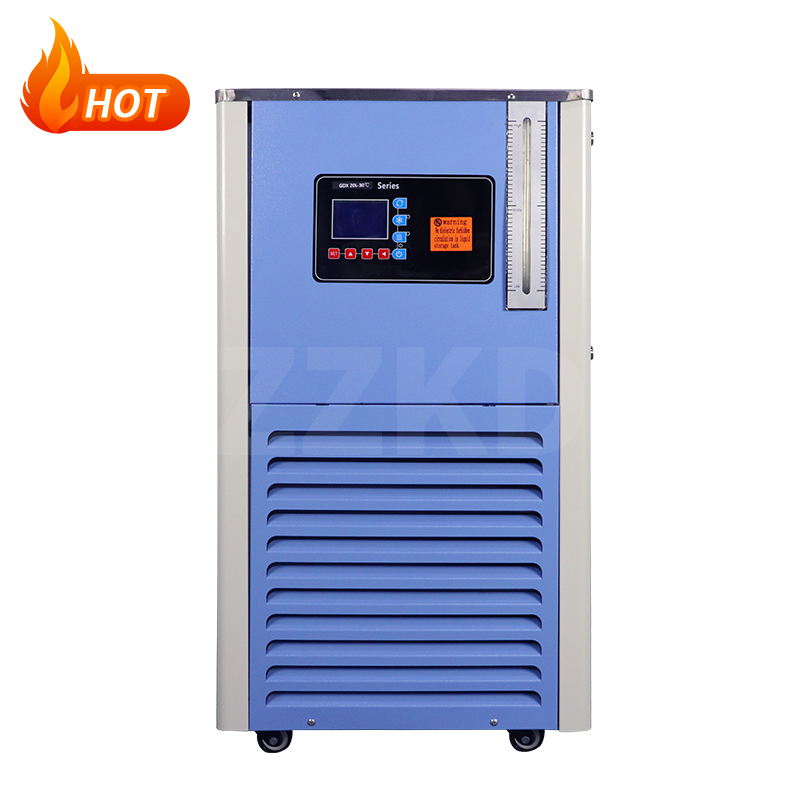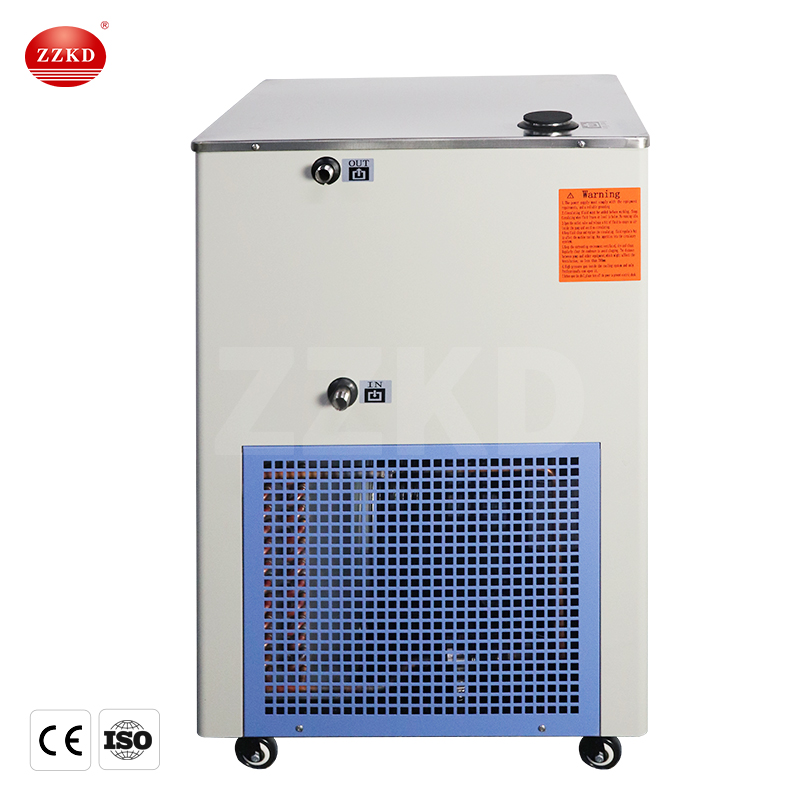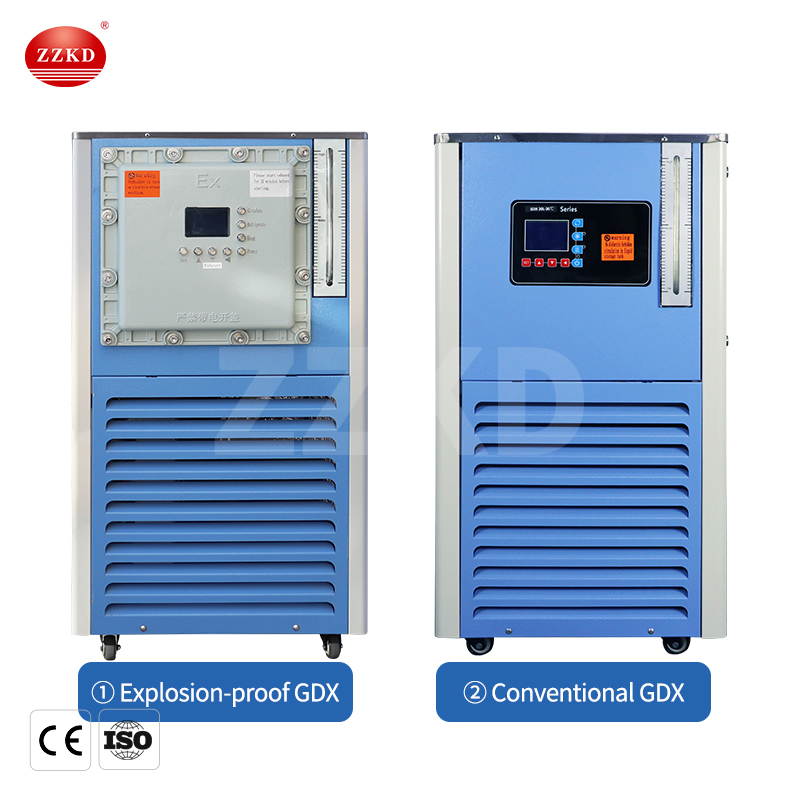- +86 17324835373
- [email protected]
- 19/F, Block B, Guohong Mansion, Zhengzhou, Henan, China
Heater chiller circulator is a laboratory equipment with dual functions of rapid cooling and heating at the same time. Using a fully enclosed pipe design, using a high-efficiency plate heat exchanger, while reducing the demand for heat transfer fluid, improves the thermal energy utilization rate of the system to achieve rapid temperature rise. It is widely used in chemistry, biology and physics laboratories, and is a cold and heat source equipment for laboratories in colleges and universities, environmental protection, biochemistry, medical, chemical and other laboratories. Heater chiller circulator can be matched with double-layer glass reactor, short-path distillation and molecular distillation.

Heater cooler circulator drives the heat transfer medium from the fuel tank equipped with the built-in heater to the temperature control device through the pump, after that, it returns to the fuel tank from the temperature control valve. The controller adjusts the temperature of the heating element according to the temperature of the heating element measured by the temperature sensor and the internal temperature of the heating element.
Heater chiller circulator is a temperature control machine that can complete both heating and cooling. It is divided into a heating part and a cooling part. Heater cooler circulator has three major components: compressor, heat exchanger (also called heat exchanger, including condenser, evaporator, economizer), expansion valve (also called throttle valve).
Condenser: The refrigerant vapor is transferred to the condenser tube bundle through the demister, and the refrigerant vapor on the tubes condenses. The exhausted heat is transferred through the cooling water through pipes. As the refrigerant is concentrated, it is collected at a low point at the bottom of the condenser.
The heat exchanger has a four-way valve, which can be used to cool and heat the heat exchanger. After the generator outlet, the heat exchanger is diluted into the upper shell solution. The solution is to bundle pipes around any steam or hot water. Steam or hot water is transferred to a tank of dilute lithium bromide solution. The refrigerant vapor sent to the condenser is concentrated upwards, leaving behind lithium bromide. The concentrated lithium bromide solution travels down a heat exchanger, where it is cooled by a weak solution pumped into a generator.
Evaporator: Liquid refrigerant flows from the upstream shell to the downstream shell condenser and evaporator. The evaporator is sprayed on the tube bundle. produce a cooling effect. The liquid refrigerant in the evaporator absorbs the heat of the water and starts to evaporate, so that there is a certain temperature difference between the refrigerant and the water. The liquid refrigerant is also completely evaporated into a gaseous state, which is then sucked into the compressor for compression (increase in pressure and temperature). The gaseous refrigerant absorbs heat through the condenser (air cooling/water cooling), condenses into liquid, and is throttled through the thermal expansion valve (or capillary tube) to become low temperature and low pressure refrigerant and enter the evaporator to complete the refrigerant cycle process.

1.Connect the liquid outlet of the heater chiller circulator to the second site inlet, and connect the liquid inlet of the circulation device to the second site outlet to form a closed circulation system.
2.The heater chiller circulator adopts a three-phase five-wire system to connect the power supply. If the line is wrong, you need to replace any two live wire positions until the indicator light of the continuous protector turns green.
3.Open the top cover of the liquid filling port of the heater chiller circulator, add heat transfer oil to the expansion oil level of the liquid storage tank, open the exhaust valve of the high and low temperature cycle integrated machine, and turn on the high-voltage power supply. Cool the all-in-one, then press the Add Liquid button to begin adding thermal oil to the system until the liquid overflows the vents.
4.Close the exhaust valve of the heater cooler circulator, open the run button, set the temperature of the high and low temperature cycle integrated machine to 150 degrees, and then continue to ventilate and add liquid to the expansion position. Close the exhaust valve, open the operation key of the high temperature and low temperature cycle machine, set the temperature to 25 degrees, continue to deflate and add liquid to the expansion position, and the test operation is completed.
5.After turning on the power of the microcomputer controller of the high and low temperature integrated machine, the actual measured temperature will be displayed. To set the temperature: Press the SET button to display SP on the upper row and the desired setting on the lower row. Press the up or down button to reach the desired setting value, then press the SET button to exit. To modify the internal parameters, please press the SET button for more than 5 seconds to display the table function menu, then click the SET button, press the password to lock the LK, then press the up button to display the LK down button is 1, then click the SET button. The required parameters can be modified in the same way. Press the SET button again for more than 5 seconds. Turn on the power of the high and low temperature cycle machine, set the desired temperature, and then press the run key switch.

1. The heating and cooling rate of the instrument is very fast, and the amount of heat transfer oil used in the instrument is also small.
2. The intelligent control function of PID is adopted, and the transmission of power is automatically adjusted by the process in the chemical process, so as to accurately control the temperature of the chemical reaction, so as to meet the requirements of the reaction process for temperature changes.
3. The instrument can achieve the safety limit value required by the manufacturer. When the safety limit value is reached, the instrument will automatically stop working and give an alarm to ensure that the reaction kettle will not be damaged due to excessive temperature difference.
4. The standard instrument adopts PLC control, which is a more user-friendly display interface (man-machine interface). The operation is very simple. The interface can display the temperature set during the working process, the outlet temperature, and the temperature in the kettle. Change the curve, so that the situation in the kettle can be observed more intuitively.
5. The instrument uses a wave plate heat exchanger, so the heat exchange speed is fast and the area is large.
6. The instrument has no internal circulation tank, and the volume of the internal circulation is very small (the volume of the internal circulation of most equipment is 6-10L)
7. The circulating pump selected by the instrument is specially customized, which can provide the maximum flow rate, generate the minimum pressure and heat, achieve the highest heat exchange efficiency, Minimum system resistance, minimum pump system heat and minimum system. energy consumption.
8. The temperature of the chemical reaction can be controlled very precisely.
Model | GDX-5/10 | GDX-5/30 | GDX-10/30 | GDX-20/30 | GDX-30/30 | GDX-50/80 | GDX-100/60 |
Temp. Range (℃) | -9~199 | -30~199 | -30~199 | -30~199 | -30~199 | -80~199 | -60~199 |
Refrigerant | R404 | R404 | R404 | R404 | R404 | R404 R23 | R404 R23 |
Cooling Capacity (W) | 380~1200 | 150~2425 | 275~2150 | 550~3460 | 850~9200 | 420~14500 | 2400~18500 |
Heating Power (W) | 1000 | 1000 | 2000 | 3000 | 4000 | 6000 | 9000 |
Total Power (W) | 1600 | 1800 | 2900 | 4300 | 6400 | 16400 | 22000 |
Circulating Pump Power (W) | 100 | 100 | 100 | 100 | 100 | 280 | 280 |
Flow (L/min) | 20 | 25 | 20 | 25 | 25 | 35 | 35 |
Lift (m) | 6 | 6 | 6 | 6 | 7 | 11 | 11 |
Voltage (V) | 220 | 220 | 220 | 220 | 220 | 380 | 380 |
Current (A) | 9 | 10 | 16 | 22 | 31 | 28 | 46 |
Please leave your contact information, we will arrange the business staff to contact you as soon as we see the message.
Copyright © 2022. ZZKD machinery equipment co., LTD All rights Sitemap